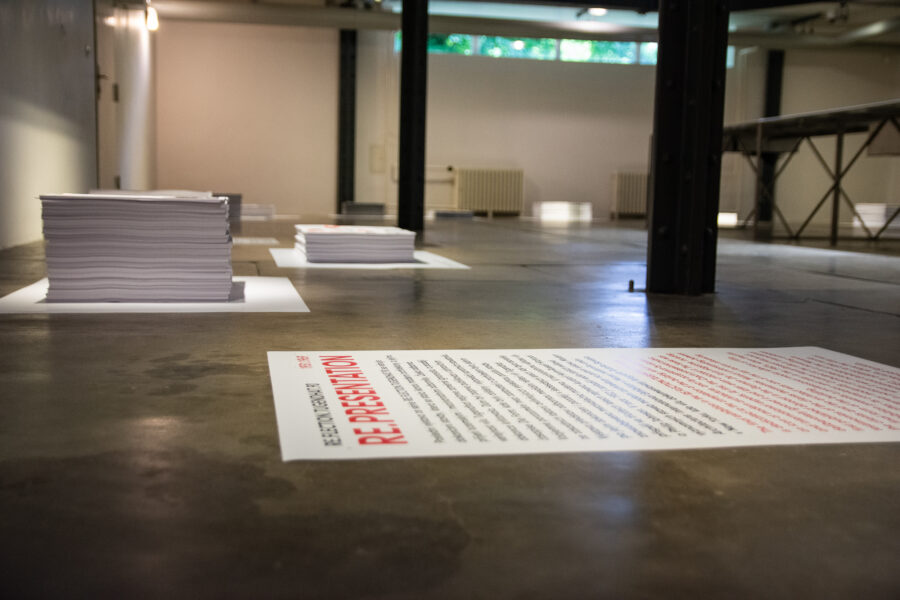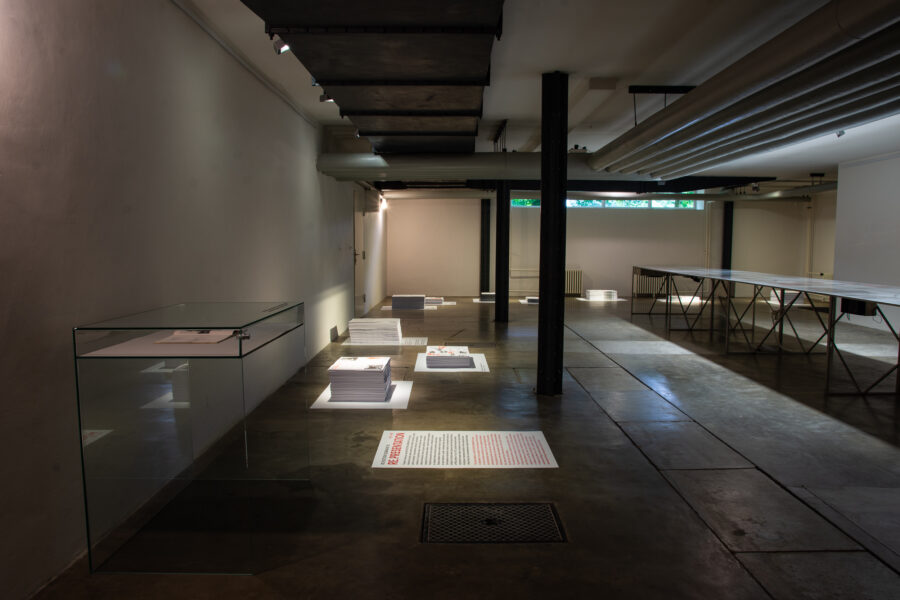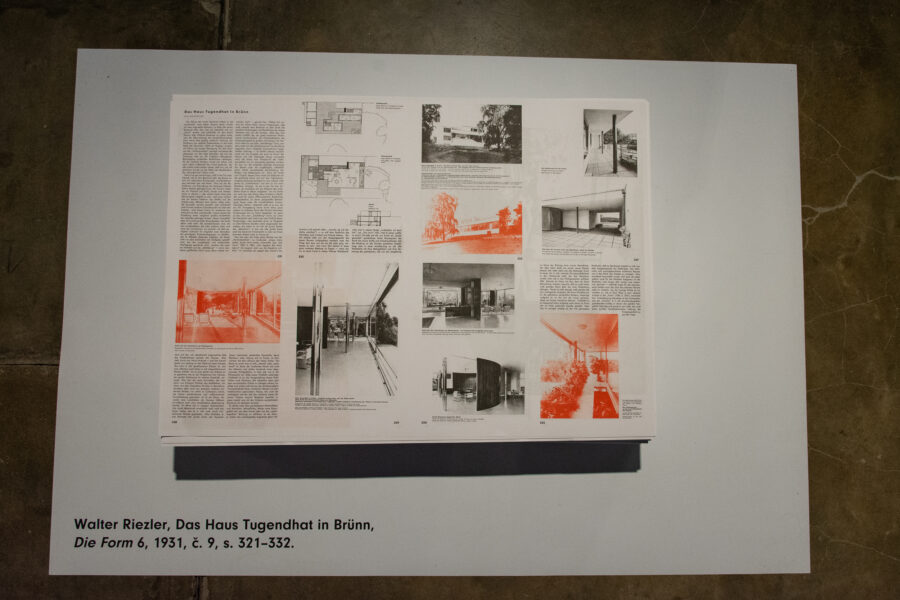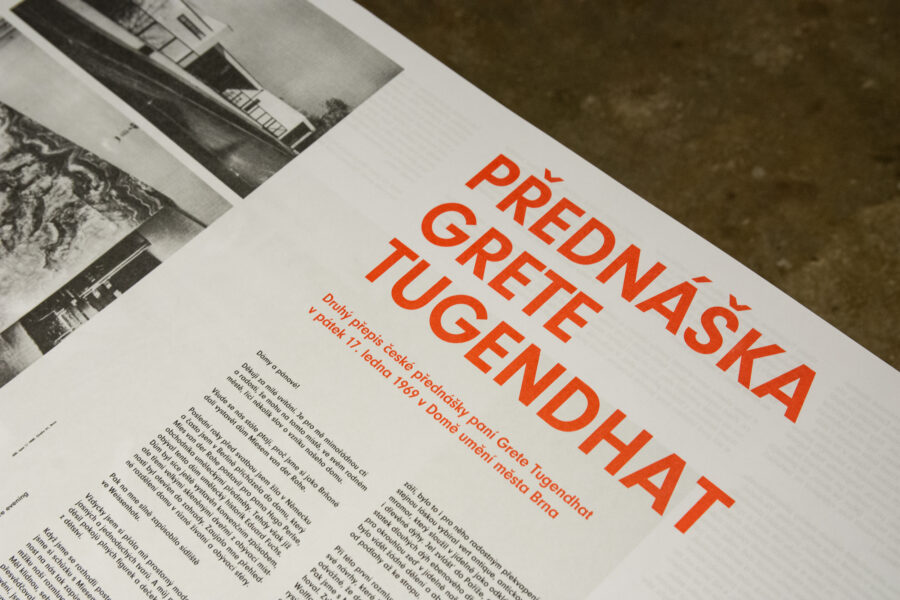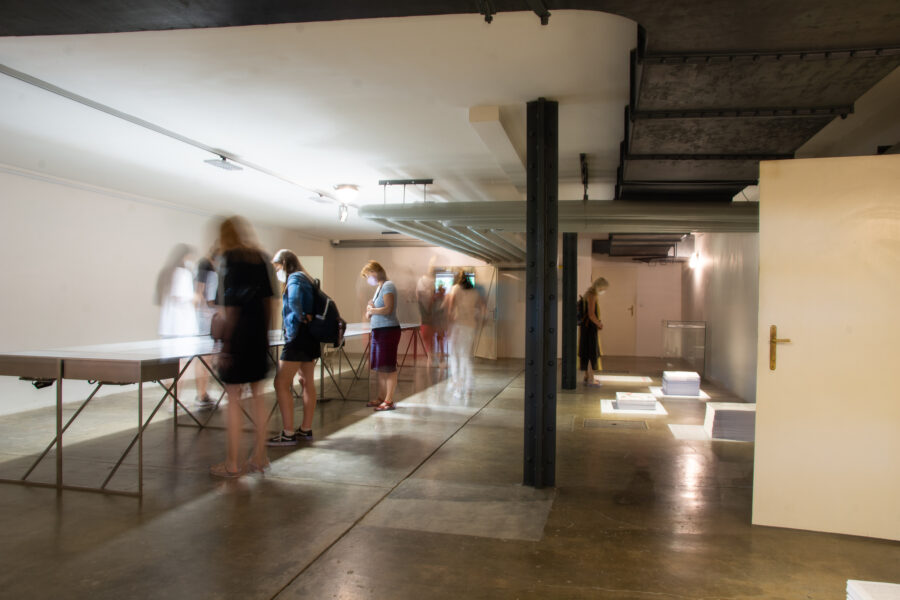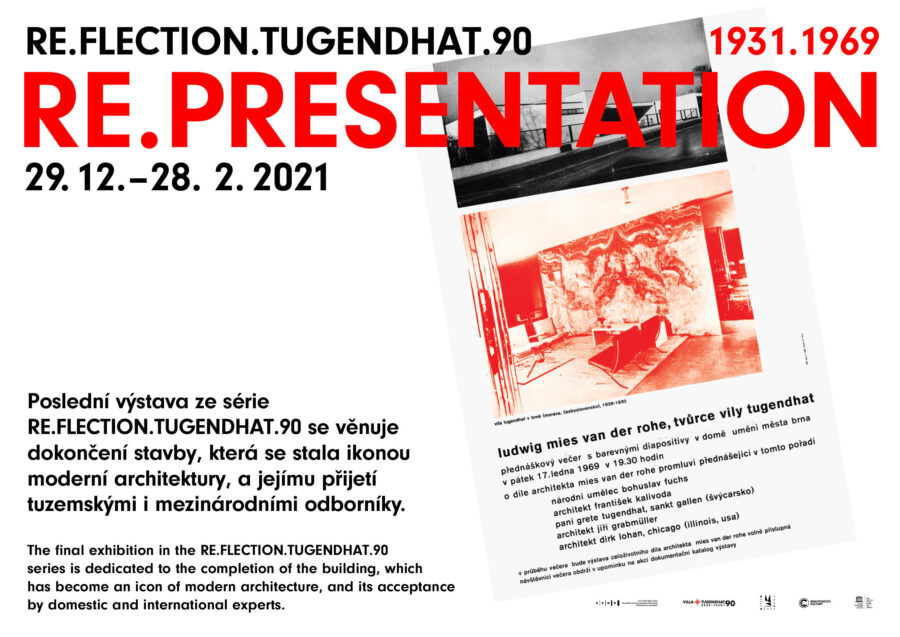15/12/2020 – 28/02/2021 / postponed to 15/6/ – 6/7/2021
The RE.PRESENTATION exhibition surveys the key reactions to the building of Villa Tugendhat chronologically from the 1930’s, the time of its creation, to the 1960’s, when theorists rediscovered interwar modernism.
Due to anti-pandemic measures, exhibition was also presented online. The curatorial selection of texts with commentary can therefore be viewed from the comfort of your own home.
The Tugendhat family home was built according to the design of the architect Ludwig Mies van der Rohe and his collaborators in 1929–1930. The uniqueness of the Brno villa lies not only in its formal architectural purity, siting in natural surroundings, and its interconnection of rooms, but also in its technical and structural design and use of fine materials. It has become Brno’s icon of modernist housing and occupies a prominent position globally and within the oeuvre of its architect. Wolf Tegethoff, a German architecture historian and Mies van der Rohe specialist, rates it alongside Frank Lloyd Wright’s house for Frederic Robie in Chicago, Adolf Loos’ Steiner Villa in Vienna and Le Corbusier’s Savoy Villa, a key modern architecture building.
Nevertheless, from the beginning, its acceptance in the professional press was not unequivocally positive. At first, the Czech professional public deliberately ignored it and later even criticized it. Mies van der Rohe’s new work was first published more than half a year after its completion, first in the foreign press – in the German professional magazine Die Form. Zeitschrift für gestaltende Arbeit, published for the German Werkbund, where it was reported on by the publisher of the magazine, Walter Riezler.
Walter Riezler, Das Haus Tugendhat in Brünn, Die Form 6, 1931, č. 9, s. 321–332.
His article then sparked a remarkable discussion on the magazine’s pages, taking place in the next two issues. In the next issue, Justus Bier asked the ubiquitous question “Can one live in the Tugendhat House?”
Justus Bier, Kann man im Haus Tugendhat wohnen?, Die Form 6, 1931, č. 10, s. 392–393.
Walter Riezler responded to his article with a comment, stating that only residents of the house could answer that question. He defended his earlier thesis that Mies’ Brno building represents the birth of a new spirit, a new humanity.
Walter Riezler, Kommentar zum Artikel von Justus Bier, Die Form, 6., 1931, č. 10, s. 393–394.
Riezler’s challenge was accepted by the villa builders themselves, each with their own letter. Interestingly, the inhabitants of the house themselves were provoked to discuss on the pages of Die Form in this way, and not its author, the architect Ludwig Mies van der Rohe, as might have been expected. The Tugendhats rejected the view that the monumental to theatrical living space allowed only a kind of festive and exhibition-style living, and instead expressed absolute satisfaction with its variability. This fact illustrates, among other things, the relationship of the clients to their house and its architect – mutual understanding was one of the key factors influencing the final appearance of the building.
Grete Tugendhat, Fritz Tugendhat, Die Bewohner des Hauses Tugendhat äussern sich, Die Form 6, 1931, č. 11, s. 437–438.
Their reaction was supplemented on the pages of Die Form magazine by a text by architect Ludwig Hilberseimer, who theoretically explained Mies’ idea of separating private rooms from the living space and his own division by onyx and Makassar partitions into smaller, “more cosy” parts.
Ludwig Hilberseimer, Nachwort zur Diskussion um das Haus Tugendhat, Die Form 6, 1931, č. 11, s. 438–439.
Ludwig Hilberseimer also published another article about the Tugendhat Villa in the German architectural magazine Der Baumeister in November 1931, where he demonstrated the innovative design and architectural significance of Mies’ Brno building in many photographs and floor plans.
Ludwig Hilberseimer, Grosses Einfamilienhaus in Brünn von Ludwig Mies van der Rohe – Berlin, Der Baumeister 29, 1931, č. 11, s. 423–431.
The entire discussion in the 11th issue of Die Form magazine concludes with a published correspondence between the French left-wing architect Roger Ginsburger aka Pierre Villon and Walter Riezler, who use the example of Villa Tugendhat and Le Corbusier’s work to discuss a purposeful and spiritual approach to building design. This is the second topical line of the whole discussion, which develops the question of whether the villa in its formal purity is a contribution to the theories of new, simple and efficient living, or whether the luxuriousness of the materials used and large size of the main living space rank it more among representative villas as the proponent of Marxist theory Pierre Villon suggested. Riezler, on the other hand, was of the opinion that Mies’ architecture further developed the principles of modern construction, technology and hygiene in a new, more spiritual direction.
Roger Ginsburger, Walter Riezler, Zweckhaftigkeit und geistige Haltung, Die Form 6, 1931, č. 11, s. 431–437.
Although the debate in Die Form was quite spirited, curators Henry-Russell Hitchcock and Philip C. Johnson in particular contributed to the villa’s international reputation by presenting it alongside other world-renowned modern architectural buildings at the Modern Architecture: International Exhibition. The exhibition was opened on 10 February 1932 at the Museum of Modern Art in New York. A photograph of the glass wall with a view of the main living space also appeared on the title page of the exhibition catalogue and helped to make the villa famous all over the world.
Henry-Russell Hitchcock, Philip Johnson, Modern Architecture: International Exhibition, Museum of Modern Art New York 1932.
It was a photo by the Brno photographer Rudolf Sandalo Jr. (1899–1980), which was probably commissioned directly by the architect Ludwig Mies van der Rohe. In the first winter months of 1931, approximately eighty pictures of the villa were taken which captured the building in all its complexity – from the exteriors in full views, semi-details and details, to similarly composed shots of the interior. It was these photographs that made Mies’ work in Brno famous. They first appeared on the pages of foreign, and later domestic, periodicals. Another Sandalo image of a part of the street facade with the rounded milky wall of the entrance part of the house was reproduced on the cover of one now iconic publication, defining a new architectural style. The book titled The International Style (New York, 1932) was prepared by Henry-Russell Hitchcock and Philip C. Johnson. The American architecture theoretician Philip Johnson, who personally visited Villa Tugendhat in the last days of August 1930, focused mainly on its aesthetic qualities. The photographic shots supported his opinion that its uniqueness is based primarily on the use of materials in the living area and Mies’ treatment of space, which he describes as free-flowing. Theorists and practitioners of the Czechoslovak architectural scene in the late 1920s and early 1930s mainly dealt with the issues of minimal standardized housing and considered the villa too ostentatious. Domestic professional periodicals ostentatiously overlooked this exceptional building or commented on it in a disparaging way.
As early as 1931, a short unsigned text was published in Žijeme magazine entitled “The Building by architect Mies van der Rohe in Brno”. Its author, probably Milena Jesenská, the wife of Jaromír Krejcar, states: “Although this is a work that clearly gives the impression of a purposeful and constructive building, a detailed inspection will convince us that the essence of the stately villa has not been abandoned, and is therefore not an act closer to the future but rather to the past.”.
Stavba architekta Miese van der Rohe v Brně, Žijeme, 1931, č. 9, s. 275.
In 1932, the architect Jaromír Krejcar used the Tugendhat Villa in his article “Apartment Hygiene” as an example unworthy of following. “From the point of view of technical progress and hygiene, these buildings are even less important than the negotiations of the municipal council in Nowheresville on the primitive sewerage system in their village.”
Jaromír Krejcar, Hygiena bytu, Žijeme, 1932, č. 5, s. 132–134, cit. s. 133.
A promoter of modern housing, engineer Miloslav Prokop, responded to Krejcar’s text in the next issue of Žijeme magazine in the Notes section. He defends Villa Tugendhat against accusations of “social sin”, and particularly praises the technical conveniences of the building. He expressed among other things a very topical consideration even today: “The builder, who in this case certainly did not build cheaply, could certainly have built a Baroque villa, for example. For that, he certainly wouldn’t be praised. Another option – to build today’s tried and tested average, which would not bring anything new. Or finally – not build at all. So which procedure is best in today’s circumstances? I think his was the one they selected.”
Miloslav Prokop, Několik poznámek k článku arch. Krejcara v 5. čísle, Žijeme, 1932, č. 7, s. 250–251.
The only positive evaluation of the building in the domestic press was brought by the magazine Měsíc, which published a Czech translation of an article by Wilhelm Bisom, accompanied by a number of Sandalo’s photographs. Bisome presented the villa as one of the highest manifestations of current mental and technical maturity.
Wilhelm Bisome, Villa arch. Mies van der Rohe, Měsíc I, červen 1932, s. 2–7.
In September 1947, a large monographic exhibition of works by architect Mies van der Rohe was held at the Museum of Modern Art in New York from 16 September to 23 November, prepared by his admirer, architectural theorist and then architecture collection curator, Philip C. Johnson. Among other things, he presented the work of Mies van der Rohe in Brno using, of course, Rudolf Sandalo’s photographs, which also appeared in the exhibition catalogue.
Philip C. Johnson, Mies van der Rohe (exhibition catalogue), Museum of Modern Art, New York 1947.
Another large travelling international exhibition dedicated to the work of Ludwig Mies van der Rohe was prepared directly by his Chicago studio, led by Mies’ grandson Dirk Lohan. Two identical copies of the exhibition collection toured the United States and Europe. František Kalivoda, who initiated a discussion on the restoration and meaningful use of the world-famous architectural building in the early 1960’s, arranged in Berlin the lending of the travelling exhibition to Brno. His aim was to emphasize the importance of the Brno villa not only in the local context, but also in the whole work of its architect and therefore in modern world architecture, to the local audience. He organized the exhibition in the Brno House of Arts from 20 December 1968 to 26 January 1969. He reported on the exhibition, but also on the Brno villa and the intention to restore it and make it accessible to the public, in the magazine Architektura ČSSR.
František Kalivoda, Otázka brněnské vily Tugendhat je vyřešena, Architektura ČSSR, roč. 28, č. 4, 1969, s. 235–241.
The accompanying programme to the Brno exhibition included a lecture evening entitled “Ludwig Mies van der Rohe, the creator of Villa Tugendhat” which was held on 17 January 1969 in the House of Arts, and where Greta Tugendhat also spoke about her villa. František Kalivoda wanted to publish a transcript of her lecture in Czech in a separate brochure with a preface. Though he didn´t manage to achieve this, the lecture was first published in abbreviated form in the Bauwelt magazine in 1969 and was published in Czech as a separate publication in 2013.
Dagmar Černoušková, Jindřich, Chatrný, Jitka Pernesová (eds.), Grete Tugendhat. František Kalivoda. Brno 1968–1969, Brno 2013.
Today, Villa Tugendhat is a standard part of all publications devoted to interwar modernity, or the ´international style´, as Philip Johnson and Henry-Russell Hitchcock called it. Mies’ iconic building has enjoyed the highest possible monument protection since 2001 thanks to its inscription on the UNESCO World Heritage List. In the Czech Republic, it is a kind of metaphor for progressive modern architecture in the mainstream press. The fact that its establishment among the iconic realizations of world architecture was not easy is proven by the presented texts of the last exhibition from the three-part series, RE.FLECTION.TUGENDHAT.90 celebrating the anniversary of the building’s completion.
Exhibition concept: Lucie Valdhansová, Barbora Benčíková, Ludmila Haasová, Neli Hejkalová
Architectural design: Studio PIXLE
Graphic design for exhibition and printed material: Studio PIXLE
Proofreading: Kateřina Havelková Štěpančíková
Translation: Kateřina Báňová
Acknowledgement: Heidelberg University Library, Moravian Library, Museum of Modern Art New York
VThe exhibition was prepared by the Tugendhat Study and Documentation Centre and has been realized with financial support from the Ministry of Culture of the Czech Republic. The exhibition is part of the Villa Tugendhat 90 celebrations held under the auspices of the Czech UNESCO Commission.


